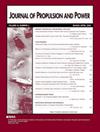用微波干涉法观察霍尔推力器中的等离子体湍流
IF 2.4
4区 工程技术
Q2 ENGINEERING, AEROSPACE
引用次数: 0
摘要
为了理解霍尔推力器中的异常电子输运,使用76 GHz微波干涉仪观察了加速通道内的等离子体湍流。通过谱密度分析和双相干分析,研究了100 ~ 500 kHz湍流幅值与磁通密度的关系,以及湍流与等离子体其他不稳定性以及湍流与放电电流的关系。湍流的电子数密度波动的振幅,积分谱密度从100到500khz,为[公式:见文本],或几乎是时间平均电子数密度的10%。湍流振幅随弱磁场强度(线圈电流小于0.6 A)的增大而减小,随磁场强度的增大而增大。湍流的振幅与放电电流呈正相关,导致加速通道内电子输运异常,并与电离不稳定性耦合。此外,观察到几百赫兹的低频扰动,与湍流正相关,并与电离不稳定性和湍流耦合。本文章由计算机程序翻译,如有差异,请以英文原文为准。
Observation of Plasma Turbulence in a Hall Thruster Using Microwave Interferometry
To understand anomalous electron transport in a Hall thruster, plasma turbulence inside the acceleration channel was observed using a 76 GHz microwave interferometer. The dependence of the amplitude of the 100–500 kHz turbulence on magnetic flux density, and the relationships between the turbulence and other plasma instabilities and between the turbulence and the discharge current were investigated through spectral density and bicoherence analysis. The amplitude of electron number density fluctuations of the turbulence, integrating the spectral density from 100 to 500 kHz, is [Formula: see text], or almost 10% of the time-averaged electron number density. The amplitude of the turbulence decreases with increase in weak magnetic field strength (coil current less than 0.6 A) and then increases with increase in magnetic field strength. The amplitude of the turbulence has a positive relation to the discharge current, leads to anomalous electron transport inside the acceleration channel, and is coupled with ionization instability. In addition, low-frequency perturbations of several hundred hertz were observed, with a positive relation to the turbulence and coupled with both ionization instability and turbulence.
求助全文
通过发布文献求助,成功后即可免费获取论文全文。
去求助
来源期刊

Journal of Propulsion and Power
工程技术-工程:宇航
CiteScore
4.20
自引率
21.10%
发文量
97
审稿时长
6.5 months
期刊介绍:
This Journal is devoted to the advancement of the science and technology of aerospace propulsion and power through the dissemination of original archival papers contributing to advancements in airbreathing, electric, and advanced propulsion; solid and liquid rockets; fuels and propellants; power generation and conversion for aerospace vehicles; and the application of aerospace science and technology to terrestrial energy devices and systems. It is intended to provide readers of the Journal, with primary interests in propulsion and power, access to papers spanning the range from research through development to applications. Papers in these disciplines and the sciences of combustion, fluid mechanics, and solid mechanics as directly related to propulsion and power are solicited.
 求助内容:
求助内容: 应助结果提醒方式:
应助结果提醒方式:


